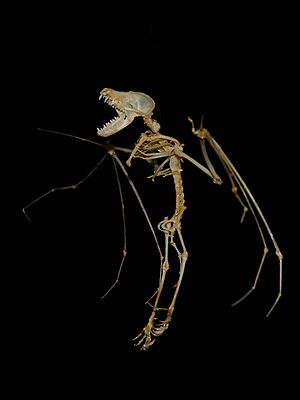Euteleostomi facts for kids

Euteleostomi (say "Yoo-tee-lee-OSS-toh-mee") is a super important group of animals! It includes almost all Vertebrates, which are animals with a backbone. Think of all the fish, amphibians, reptiles, birds, and mammals you know – most of them are Euteleostomi! The main things that make Euteleostomi special are their skeletons, which are mostly made of bone, and a strong skull protecting their brain. Only a few groups like hagfish, lampreys, and cartilaginous fishes (like sharks and rays) are vertebrates but not part of the Euteleostomi family.
Contents
What Are Euteleostomi?
Euteleostomi is a scientific name that means "true bony mouths." This group is sometimes also called "bony vertebrates." It's the largest group of vertebrates on Earth! If an animal has a backbone and its skeleton is made of bone, it's very likely an Euteleostomi.
Who Belongs to This Group?
This amazing group includes a huge variety of animals.
- Bony Fish: Most of the fish you see, from tiny goldfish to giant tuna, are bony fish. They make up a massive part of the Euteleostomi.
- Amphibians: Animals like frogs, toads, and salamanders, which can live both in water and on land, are Euteleostomi.
- Reptiles: Snakes, lizards, turtles, and crocodiles are all part of this group.
- Birds: Every bird, from a small hummingbird to a huge eagle, is an Euteleostomi.
- Mammals: This includes us humans, along with dogs, cats, elephants, whales, and all other mammals.
What About the Exceptions?
While most vertebrates are Euteleostomi, there are a few interesting exceptions.
- Hagfish and Lampreys: These are ancient, jawless fish. They have a backbone, but their skeletons are made of cartilage (a softer, bendier material than bone), not bone.
- Cartilaginous Fishes: This group includes sharks, rays, and chimaeras. Their skeletons are also made entirely of cartilage, not bone. This is why they are not part of the Euteleostomi.
What Makes Euteleostomi Special?
The defining features of Euteleostomi are their bony skeletons and skulls.
- Bony Skeleton: Unlike cartilage, bone is a very strong and rigid material. This allows Euteleostomi to grow larger and support their bodies better, especially on land.
- Skull: All Euteleostomi have a well-developed skull. This bony box protects their brain, which is a very important organ.
- Special Cases: Interestingly, some fish, like the sturgeon, have skeletons that are mostly bone when they are young. But as they get older, parts of their skeleton can turn back into cartilage. This shows how adaptable nature can be!
A Look at Their History
Euteleostomi have been around for a very long time. Scientists believe they first appeared during a period called the Silurian period, which was about 443 to 419 million years ago. This makes them one of the oldest and most successful groups of animals on our planet. Over millions of years, they have evolved into the incredible diversity of life we see today, from fish swimming in the deepest oceans to birds soaring in the sky and mammals walking on land.

